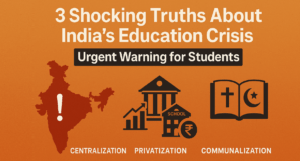3 Shocking Truths About India’s Education Crisis | Urgent Warning for Students
India’s education system is facing three major challenges: centralization, commercialization, and communalization. The government has concentrated control over education, sidelining state governments and enforcing policies without consultation, such as the PM-SHRI school model. In higher education, state universities are losing autonomy as vice-chancellor appointments are increasingly controlled by the central government. Meanwhile, privatization has led to the closure of nearly 90,000 public schools, pushing students into expensive private institutions.
Universities are forced to take loans, repaid through student fees, making education unaffordable. Corruption is rising, with scandals in accreditation and examination agencies further eroding trust. Additionally, textbooks have been rewritten to align with ideological narratives, and top university positions are being filled based on political loyalty rather than merit. These issues threaten educational accessibility, quality, and fairness, putting future generations at risk.

3 Shocking Truths About India’s Education Crisis | Urgent Warning for Students
India’s National Education Policy (NEP) 2020 was introduced as a major reform, but the government’s handling of education has been largely indifferent. Over the past decade, three key issues have dominated the education system—centralization of power, privatization, and communalization. These trends are harming students and jeopardizing the country’s future.
1. Excessive Centralization of Power
The central government has increasingly taken control of decision-making, reducing the role of state governments. For instance, the Central Advisory Board of Education (CABE), which includes both central and state education ministers, has not convened since 2019. This lack of consultation is alarming, especially since NEP 2020 brought significant changes without proper dialogue.
Another major concern is the PM-SHRI school scheme, where the government pressures states to adopt it by withholding funds originally meant for the Samagra Shiksha Abhiyan (SSA)—a program critical for implementing the Right to Education (RTE) Act. Even a bipartisan parliamentary committee has criticized this approach.
In higher education, the University Grants Commission (UGC) has introduced new rules stripping state governments of their authority to appoint vice-chancellors in state universities. Instead, governors—who typically align with the central government—now hold this power. This move undermines India’s federal structure and limits states’ role in shaping their own education policies.
2. Growing Privatization of Education
The rapid shift from public to private education is making schooling unaffordable for many. The NEP encourages replacing neighborhood schools with “school complexes,” leading to widespread closures of government schools. Since 2014, 89,441 public schools have shut down, while 42,944 private schools have opened, forcing low-income families into costly private institutions.
In higher education, the government has cut direct funding and introduced the Higher Education Financing Agency (HEFA), which forces universities to take loans instead of receiving grants. Alarmingly, 78% to 100% of these loans are repaid by increasing student fees, placing a heavy financial burden on students.
Corruption has also become a growing problem. Scandals like the bribery case in the National Assessment and Accreditation Council (NAAC) and mismanagement in the National Testing Agency (NTA) highlight how commercialization is harming the integrity of the education system.
3. Increasing Ideological Influence in Education
There is a rising trend of rewriting history and promoting ideological narratives in education. The National Council of Educational Research and Training (NCERT) has made controversial textbook revisions, such as removing references to Mahatma Gandhi’s assassination and downplaying the Mughal era. Even the Preamble of the Indian Constitution was initially removed from textbooks, only to be reinstated after public backlash.
In universities, faculty appointments are increasingly influenced by political loyalty rather than academic merit. Many top positions in institutions like IITs and IIMs are being given to individuals aligned with the government’s views rather than the most qualified candidates. The UGC’s recent proposal to lower qualification standards for professorships further suggests a shift toward prioritizing ideology over expertise.
Conclusion
The combined impact of centralization, privatization, and ideological interference is weakening India’s education system. Instead of strengthening public education, these policies are making it harder for poor and middle-class students to access quality learning opportunities. If these trends continue, they will have long-term consequences for India’s progress and future generations. The government must prioritize inclusive, affordable, and unbiased education to secure a better future for all.
You must be logged in to post a comment.